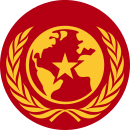More languages
More actions
The Đổi Mới Reforms were a set of reforms which transformed Vietnam into a socialist-oriented market economy. It was launched in December 1986 by the Communist Party of Vietnam’s 6th National Congress; the word “Đổi Mới” is a Vietnamese phrase meaning “restoration”. The Communist Party of Vietnam deemed these reforms necessary as just about a decade earlier they were at war with the U.S. and had strict sanctions put onto them by the U.S. By 1986, this left the country with inflation hitting 700% a year and it's exports amounted to around $500 million, less than half of it's imports ($1.22 billion)[1]. Vietnam was also isolated as other socialist countries at the time were (except China), and Agent Orange had rendered much of the farmland unusable, so they decided to open up to the outside world and introduce a market economy, albeit with a predominance of state-owned industry and still guided by central planning; this came with a drastic reduction in Soviet economic and military assistance after the mid 1980s and opening up to the rest of the world by allowing foreign direct investment and more exportation of rice.[2][3]
Reforms[edit | edit source]
With the current economic situation, multiple local party organizations held meetings, expressing dissatisfaction with the economic program in Vietnam, issuing strong reiteration of local executive committee planning commitments.[4] A Politburo session was held to discuss policy disagreement, which ended with a set of issues which were broadly agreed on, including:
- the imperative requirements of the "new revolutionary stage";[5]
- the need for "new economic thinking and concepts";[5]
- the panoply of socio-economic tasks confronting an economy with a history of imbalance and injudicious investment priorities;[5]
- the continued importance of eliminating bureaucratic centralism and subsidization, and the concommitant need to redefine management mechanisms and planning procedures.[5]
During the 6th National Congress of the Communist Party of Vietnam, the Party Congress endorsed previously discussed reforms with the task of gaining economic stability overtime, and issued 5 key points:
- concerted efforts to increase the production of food, consumer goods and exportable items;[5]
- continue the efforts to control small merchants and private capitalist trade, while acknowledging the reality of a persistent multisector economic structure;[5]
- a combined effort to regenerate the planning bureaucracy and to form an effective economic management structure capable of independent decision-making and able to manage a sensitive market, adjust investments, and guide sectoral plans through the encouragement of economic contracts;[5]
- the clarification of lines of governmental authority, and the reorganization of the state management apparatus in the direction of a compartmentalized and concise system of institutions;[5]
- the improvement of party organizational capabilities, leadership, and cadre training.[5]
Alongside it, the Congress served the purpose of self-criticism, with the Party Central Committee, Politburo, Party secretariat and the Council of Ministers stating they were responsible for poor decision making and implementation of policy during struggling economic times.[5]
See also[edit | edit source]
References[edit | edit source]
- ↑ Cuong Dinh Tran (2022). EY Vietnam 30th Anniversary Book: 'Carrying the torch'.
- ↑ Hong Anh Tuan. "Doi Moi and the Remaking of Vietnam" GlobalAsia. Retrieved 2022-10-5.
- ↑ "Vietnam Foreign Direct Investment 1970-2022". Marcrotrends.
- ↑ Lewis M. Stern (1987). Party Reform Initiatives, the Scramble towards Economic Revitalization, and the Road to the Sixth National Congress (p. 14). ISEAS - Yusof Ishak Institute.
- ↑ 5.0 5.1 5.2 5.3 5.4 5.5 5.6 5.7 5.8 5.9 Lewis M. Stern (1987). Party Reform Initiatives, the Scramble towards Economic Revitalization, and the Road to the Sixth National Congress (p. 15). ISEAS - Yusof Ishak Institute.
